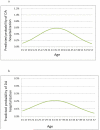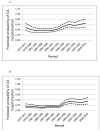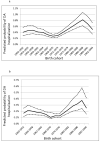Age, period and cohort trends in drug abuse hospitalizations within the total Swedish population (1975-2010)
- PMID: 24300899
- PMCID: PMC3909834
- DOI: 10.1016/j.drugalcdep.2013.11.011
Age, period and cohort trends in drug abuse hospitalizations within the total Swedish population (1975-2010)
Abstract
Background: The societal consequences of drug abuse (DA) are severe and well documented, the World Health Organization recommending tracking of population trends for effective policy responses in treatment of DA and delivery of health care services. However, to correctly identify possible sources of DA change, one must first disentangle three different time-related influences on the need for treatment due to DA: age effects, period effects and cohort effects.
Methods: We constructed our main Swedish national DA database (spanning four decades) by linking healthcare data from the Swedish Hospital Discharge Register to individuals, which included hospitalisations in Sweden for 1975-2010. All hospitalized DA cases were identified by ICD codes. Our Swedish national sample consisted of 3078,129 men and 2921,816 women. We employed a cross-classified multilevel logistic regression model to disentangle any net age, period and cohort effects on DA hospitalization rates.
Results: We found distinct net age, period and cohort effects, each influencing the predicted probability of hospitalisation for DA in men and women. Peak age for DA in both sexes was 33-35 years; net period effects showed an increase in hospitalisation for DA from 1996 to 2001; and in birth cohorts 1968-1974, we saw a considerable reduction (around 75%) in predicted probability of hospitalisation for DA.
Conclusions: The use of hospital admissions could be regarded as a proxy of the population's health service use for DA. Our results may thus constitute a basis for effective prevention planning, treatment and other appropriate policy responses.
Keywords: Age–period–cohort effects; Drug abuse; Longitudinal; Sweden; Trends.
Copyright © 2013 Elsevier Ireland Ltd. All rights reserved.
Figures
References
-
- Alexandre PK, Roebuck MC, French MT, Chitwood DD, McCoy CB. Problem drinking, health services utilization, and the cost of medical care. Rec. Dev. Alcohol. 2001;15:285–298. - PubMed
-
- Arendt M, Munk-Jorgensen P, Sher L, Jensen SO. Mortality among individuals with cannabis, cocaine, amphetamine, MDMA, and opioid use disorders: a nationwide follow-up study of Danish substance users in treatment. Drug Alcohol Depend. 2011;114:134–139. - PubMed
-
- Centralförbundet för alkohol- och narkotikaupplysning . Drug tendencies in Sweden 2011. Stockholm: 2012. p. 93. Drogutvecklingen i Sverige 2011.
-
- Degenhardt L, Chiu W-T, Sampson N, Kessler RC, Anthony JC, Angermeyer M, Bruffaerts R, de Girolamo G, Gureje O, Huang Y, Karam A, Kostyuchenko S, Lepine JP, Mora MEM, Neumark Y, Ormel JH, Pinto-Meza A, Posada-Villa J, Stein DJ, Takeshima T, Wells JE. Toward a global view of alcohol, tobacco, cannabis, and cocaine use: findings from the WHO World Mental Health Surveys. Plos Med. 2008;5:1053–1067. - PMC - PubMed
Publication types
MeSH terms
Grants and funding
LinkOut - more resources
Full Text Sources
Other Literature Sources
Medical




